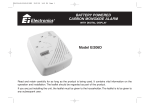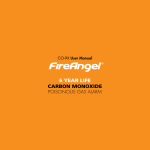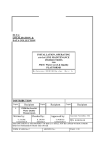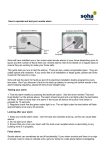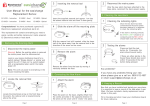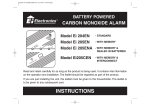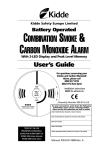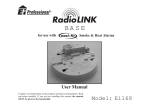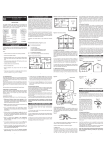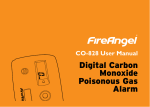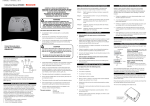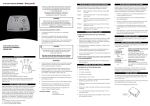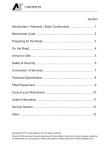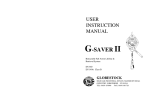Transcript
MAINS POWERED ? CARBON MONOXIDE ALARMS Read and retain carefully for as long as the product is being used. It contains vital information on the operation and installation. The leaflet should be regarded as part of the product. The CO Alarm case will feel slightly warm after it has been powered for a while. This is normal as the alarm uses a sophisticated heated sensor to detect the CO gas. ? What to do when the Alarm sounds: (1) Open the doors and windows to ventilate. (4) Ring your gas or other fuel supplier on their emergency number; keep the number in a prominent place. 2. C - Interconnect (5) Do not re-enter the property until the alarm has stopped. (If the alarm has been silenced by pressing the test/hush button, wait at least 5 minutes so the alarm can check that the CO has cleared). 2.1 What is Carbon Monoxide ? (6) Get medical help immediately for anyone suffering the effects of Carbon Monoxide poisoning (headache, nausea), and advise that carbon monoxide poisoning is suspected. © Ei Electronics 2002 (7) Do not use the appliance again until it has been checked by an expert. In the case of gas appliances this must be a CORGI registered installer. P/N B13073-4 READ THIS FIRST WARNINGS ? The Alarm should be permanently wired to the mains by a qualified electrician in accordance with IEE wiring regulations. Do not locate the CO Alarm where it could be exposed to dripping, splashing or condensation (e.g. bathroom, above an electric kettle etc). Install the Carbon Monoxide Alarm (CO Alarm) in or near every room that contains a fuel burning appliance, particularly rooms where people spend a lot of time e.g. bedrooms kitchens, sitting rooms. Install preferably on the ceiling (300mm from walls) in rooms with an appliance. Install between 1m to 3m horizontally from appliance. In rooms remote from the appliance install about 1.5m to 2m above floor level at breath level. ? ? x When the CO Alarm detects abnormal levels of CO (above 150ppm CO for 30 minutes) the horn sounds and the red light starts to flash. At higher levels of CO the alarm will turn on sooner (see table B). Many are killed each year, and many more suffer ill health from Carbon Monoxide (CO) poisoning. CO is an invisible, odourless, tasteless and extremely toxic gas. It is produced by appliances or vehicles burning fuels, such as coal, oil, natural / bottled gas, paraffin, wood, petrol, diesel, charcoal etc. CO is absorbed by red blood cells in the lungs in preference to oxygen - this results in rapid damage to the heart and brain from oxygen starvation. High levels of CO in a house can be caused by: • Incorrectly or poorly installed fuel-burning appliances. • Blocked or cracked chimneys / flues. WARNING: The CO Alarm is no substitute for keeping chimneys and flues clear and in good condition, and all of your appliances serviced regularly according to the manufacturer’s instructions. 2.2 Symptoms of Carbon Monoxide Poisoning Do not fit alarm until all building work is completed to avoid contamination. • Blocked vents or draught-proofing which makes areas with fuel burning appliances or fireplaces airtight. • Engines of cars, lawnmowers etc., left running in confined spaces. • Portable paraffin or gas heaters in badly ventilated rooms. Most people know that high levels of CO are harmful, however the period of exposure is also important. The following symptoms are related to Carbon Monoxide poisoning and should be discussed with all members of the household. British Standard BS7860 : 1996 gives the following advice: Red Alarm Light Time to first Symptom* -------30 min 6 min off ----------90 min 30 min Flashes every 2 sec Flashes every 0.5 sec Ideally you should have a detector in or near every room that contains a fuel-burning appliance. However, if you have more than one appliance, but only one detector, you should take the following into consideration when deciding where best to put the detector. (1) If there is an appliance in the room where you sleep, you should put the detector in that room. (2) If there is an appliance in a room that you use a lot, e.g. a sitting room, you should put it in that room. *Slight Headache Table B shows how the built in microprocessor reacts to different levels of CO gas and exposure time. At higher levels of CO the alarm turns on sooner. The rate of flashing of the red light indicates the level of CO. If your CO Alarm sounds follow the instructions on page 2. When ventilation is provided by leaving the windows and doors open, the CO build up may have dissipated by the time help arrives and the alarm may have stopped sounding. Although your problem may appear temporarily solved it is crucial that the source of the CO is determined and appropriate repairs made. (3) If you live in a bedsit, put the detector as far away from the cooking appliances as possible, but near to the place where you sleep. (4) If the appliance is in a room not normally used (e.g. a boiler room), put the detector just outside the room so that you will be able to hear the alarm more easily. Ideally you should have a detector in or near every room that contains a fuel-burning appliance. Figure 2 BEDROOM * SITTING ROOM * KITCHEN * 3.1 Suitable Locations Ei Electronics recommends that the advice of the Health & Safety Exectutive (HSE) UK is followed as this is based on research done at the BRE subsequent to the issueing of the BS 7860 : 1996 standard. - In rooms with flueless or open flued appliances If locating the CO Alarm in a room remote from the appliance: - the alarm should be located at a level similar to the breathing zone of the occupant (typically in living rooms at 1.5m to 2.0m above floor level and in bedrooms at the height of the bed). (3) In or below a cupboard. Figure 3: HSE Recommended locations (3) If the CO Alarm gives a short beep and the amber fault light flashes every 4 seconds it means the self-checking circuitry may have detected a fault. Press and hold the test / hush button until the horn sounds and it resets the unit. If the beeping starts again the Alarm is defective. 8. Connect the mains power to the CO Alarm circuit. The green power light should turn on. Check the full operation of the CO Alarm as outlined below in “Testing Your CO Alarm”. Figure 5 The alarm does not need to be earthed, however for convenience a spare terminal is provided to hold an earth wire if present. Interconnect (Ei 225 with a suffix “C” only) The interconnect wires can be used to interconnect up to 12 units (Ei 225 with a suffix “C”) so that when one unit senses Carbon Monoxide all alarm (the unit sensing CO can be identified by its flashing red alarm light). Connect all the grey wires (terminal 7) together and all the yellow wires (terminal 6) together as shown in Figure 6. Figure 6 MODEL Ei 225CR MODEL Ei 225C Testing your CO Alarm (1) Regularly check that the green mains power light is on the unit cannot detect CO if the mains power is not on (if it is off check circuit breakers, fuses, wiring etc.). 9 10 (2) Test the unit weekly by pressing the test/hush button. diesel, charcoal etc. with care, and have them professionally installed and regularly maintained. (3) These appliances must “breathe in” air to burn the fuel properly. Know where the air comes from, and ensure vents/air bricks etc. remain unobstructed (particularly after building work). (4) The appliances must also “breathe out” the waste gases (including the CO) - usually through a flue or chimney. Ensure chimneys and flues are not blocked or leaking, and get them checked every year. Check for excessive rust or cracks on appliances and pipework. (10) Install CO Alarms in all areas recommended in this leaflet. (11) Recognise that CO poisoning may be the cause when family members suffer from “flu-like” symptoms when at home but feel better when they are away for extended periods. Power : 6 Watts Power on Indicator : Green light on. Sensor : Semiconductor Gas Senor Checks CO concentration every 2.5 minutes. Temperature cycled between measurements to ensure high sensitivity to CO and also high immunity to false alarms from other gases.Chemical filter on sensor enhances sensitivity and selectivity. - A strange smell when an appliance is working. - A naked gas flame which is yellow or orange, instead of the normal blue. - Family members (including pets) exhibiting the “flu-like” symptoms of CO poisoning described above. (1) Ensure there are no fuel burning appliances in the vicinity which could be leaking CO gas (e.g. even from next door). (2) Ensure there are no fumes in the area (e.g. paint, thinners, hair spray, chemical cleaners aerosol sprays etc). (3) Ensure there is no outdoor source of CO in the vicinity (e.g. a car with engine running, heavy traffic, heavy air pollution, barbecue fumes etc). (4) Press the test / hush button to silence the alarm. If the unit continues to sound it is possibly defective and should be replaced, follow the instructions in section 5 on “How to disconnect and remove your alarm” and then see section 9 “Getting the CO Alarm Serviced”. 5. TEST / HUSH BUTTON DOES NOT SILENCE ALARMS: If there are a number of alarms interconnected and they are all sounding, pressing the test / hush button on the unit sensing CO (i.e. the one with the red light flashing) will silence the system. Pressing any other test / hush button will not silence the alarms. The unit cannot be hushed at a level of 350ppm CO or greater. 17 Electrical Safety : CO Sensitivity : Meets or exceeds the CO sensitivity specifications in BS 7860 : 1996 14 Complies with BS 7860 : 1996 Electromagnetic Compatibility : Complies with BS EN 50081-1 : 1992 and BS EN 50082-1 : 1992. Test / Hush Button : Checks electronics and horn. When the unit is alarming, after sensing about 150ppm of CO, pressing the test / hush button will immediately stop the horn and turn off the red light. (With interconnect units, the hush only works on the alarm sensing CO). If CO is still present the red light and the horn will turn on again after about 2.5 minutes. It can be only be hushed once at 150ppm CO. It cannot be hushed at about 350ppm CO. Operating Temperature : -5°C to 40°C (23°F to 104°F) Humidity Range : 15% to 95% R.H. (non-condensing) Audible Alarm : 85dB(A) at 3m (10ft) minimum Self Diagnostics : Horn beep and amber fault light flashes every 4 seconds if a fault is found. Tamperproof : Screwdrivers needed to unscrew mains cover over terminal block, and to remove unit from wall. Interconnect : Up to 12 Ei 225C Alarms only can be interconnected, so that when one senses CO, all alarm. Technical Information - Staining, sooting or discolouration on or around the unit. Use the narrow nozzle of a vacuum cleaner to remove fluff and other contamination from the cover slots to ensure CO gas can reach the sensor. Caution: Do not paint the CO Alarm. Remove the CO Alarm when decorating. Do not allow water or dust to contaminate the alarm (see below). Warning: Do not open or tamper with the CO Alarm. There are no user serviceable parts inside. This can damage the unit and may expose the user to shock or fire hazards. How to disconnect and remove the alarm: 2. Slide cover up as shown in figure 1. 3. Unscrew the terminal cover screw. 6. (with “C” suffix only) Relay Output : (with “R” suffix only) Built-in relay is available with isolated contacts rated Limitations of CO Alarms (1) The Ei 225 CO Alarm will not work without mains power - the green power light must be on at all times. (2) Carbon Monoxide must enter the unit for it to be detected.There may be Carbon Monoxide in other areas of the house (e.g. downstairs, in a closed room etc.) but not in the vicinity of the CO Alarm. Doors, air draughts and obstructions can prevent the CO reaching the Alarm. For these reasons we recommend CO Alarms are fitted both near and in bedrooms, particularly if bedroom doors are closed at night. Additionally in rooms where members of the household spend much of their time, and in rooms with potential sources of CO gas. (3) The CO Alarm may not be heard. The sound output is loud, but it may not be heard behind a closed door or if it is too far away. Interconnecting CO Alarms greatly improves the probability that they will be heard. The Alarm may not wake up somebody who has taken alcohol or drugs. The alarm sound may be masked by other sounds such as a T.V., stereo, traffic noise etc. Fitting CO Alarms on either side of closed doors will improve their chance of being heard. This CO Alarm is not designed for people with impaired hearing. (4) CO Alarms don’t last indefinitely. CO Alarms are sophisticated electronic devices with many parts. Although the alarm and its component parts have undergone stringent tests, and are designed to be very reliable, it is possible 11 (8) Children should be warned of the dangers of CO poisoning and instructed never to touch, or interfere with the CO Alarm. Do not allow small children to press the test / hush button as they could be subjected to excessive noise when the unit alarms. 230±10% VAC, 50Hz Follow the detailed instructions on the top of page 2. entitled “What to do when the alarm sounds”. Clean the outside case by occasionally wiping with a clean damp cloth (disconnect the mains supply at the distribution / fuse board first). Do not use any cleaning agents, bleaches, detergents or polishes, including those in aerosol cans. Avoid spraying air fresheners, hair spray, paint or other aerosols near the CO Alarm. Do not place air fresheners near (7) Never use a gas cooker or a barbecue for home heating. Operating Voltage : 4. ALARM SOUNDS FOR NO APPARENT REASON: Maintaining your CO Alarm (6) Never adjust your own gas pilot lights. - The CO Alarm warning of abnormal levels. seconds, the CO sensor is possibly defective. Press the test/hush button to reset the unit. If the beeping and the amber light flashing re-occurs after 2.5 minutes, the unit is defective. How to distinguish between CO Alarm and Smoke Alarm warnings (5) Never leave your car, motor bike or lawnmower engine running in the garage with the garage door closed. Never leave the door from the house to the garage open if the car is running. (9) Leaving windows or doors slightly open (even a few inches) will significantly reduce the risk of high levels of CO occurring. The high levels of draught-proofing in modern houses reduces ventilation and allows dangerous gases to build up. 8 5. Unscrew from the wall. 5. 8. 5. (a) If the wires are coming directly out from the ceiling / wall locate the wire entry slot over the wire and mark the two screw locations. Screw the unit to the ceiling / wall (ensure screws do not penetrate buried wires. The unit can also be screwed on to a standard recessed junction box if required. Seal around the wires where they come out from the ceiling / wall with silicone rubber or similar, to prevent air draughts affecting the unit. The CO Alarm is fully operational and will provide protection against a build up of carbon monoxide gas after it is connected to the mains supply. The unit reaches its optimum performance after it has been powered for 72 hours. Testing both your CO Alarms and Smoke Alarms weekly will help you and your family to clearly distinguish between them in an emergency. 4. 13 Precaution: Do not install the actual alarm itself in new or renovated buildings until all work is completed, including painting, and the building has been fully cleaned. Wiring can be installed when appropriate. (Excessive fumes from paints, solvents, cleaning agents etc. may damage the sensor). 4. Disconnect the wires from the terminal block and make safe, particularly if the circuit is going to be turned on again after the CO Alarm is removed. In addition, when your CO Alarm is sounding the red alarm light in the centre of the cover will be flashing. The relay wires (terminals 1,2 & 3) can be connected to suitable load in the normal way -see Figure 6 (maximum load 250VAC / 8 Amps). The relay contacts are electrically isolated. Please note the relay is not latching i.e. it only stays switched while CO is being sensed. When the CO clears the (2) Choose all appliances and vehicles which burn fossil fuels such as coal, oil, natural / bottled gas, paraffin, wood, petrol, (2) Do not use the CO Alarm on an intermittent basis, or as a portable detector for the spillage of combustion products from fuel-burning appliances or chimneys. If the CO Alarm fails any of the above tests it must be replaced immediately (see section 9 “Getting the CO Alarm Serviced”). The CO Alarm has a distinctive on-off sound of 3 pulses, followed by a pause as compared with a typical Smoke Alarm which has a rapid pulsing sound. Relay (Ei 225 with a suffix “R” only) If any of these signs are present get the appliance checked out by an expert before further use. If family members are ill get medical help. (1) The CO alarm should be installed by a qualified electrician in accordance with the IEE wiring regulations (BS 7671). Failure to install this alarm correctly may expose the user to shock or fire hazards. 1. First disconnect the mains supply to the CO Alarm circuit at the distribution / fuse board. It is recommended that the alarm is tested with actual Carbon Monoxide annually. This can be done by using one of the propriety kits that comes with CO either in a glass phial or aerosol can. Follow the instructions on the kit and be sure the CO is retained in the unit for at least 6 minutes. A maximum of 250 metres (820ft) of wire can be used (maximum resistance between detectors 50 ohms) to interconnect the Carbon Monoxide Alarms. The interconnect wires connect to the yellow and grey wires, terminals 6 & 7 and must be kept electrically isolated from the mains wiring for safety. - A pilot light frequently going out. Warnings: (4) If the Alarm fails to operate when the test/hush button is pressed, disconnect the mains supply at the distribution fuse board for 3 minutes, re-connect the mains and try again. (This procedure resets the microprocessor in the unit). Testing with Carbon Monoxide Warning: Do not interconnect these alarms to any other type of Ei alarm, including smoke / heat alarms, or to any othe model. Doing this may damage the alarm and could result i a shock or fire hazard. appliances. Figure 3A: BS 7860 : 1996 recommendation 7 Figure 4: Locations for Surface Wiring (1) Know and look out for tell-tale signs that Carbon Monoxide may be present. These include: 1.85m (min) (b) If surface wiring is being used bring the wiring in from either of the vertical sides or the bottom as shown in Figure 4. Note surface wiring cannot be brought in from the top as it would be in the way of the cover sliding off and also might allow water to penetrate. Screw the unit to the wall. 7. After the terminal block is fully wired replace the terminal block cover and screw it on. Then slide on the outer cover. Follow these guidelines to reduce the risk of Carbon Monoxide poisoning. When the Alarm detects dangerous levels of CO, it sounds a loud alarm and flashes the red alarm light. 4. Remove the terminal cover screw and expose the connecting terminals. (2) Outside the building. Hold the test button for 5 seconds until the red alarm light flashes and the horn sounds for over 5 seconds. This will help to familiarise you and your family with the distinctive on-off sound of the CO Alarm. This test checks that the electronics and the horn are working correctly. Do not try to test the CO Alarm in any other way. If the units are interconnected, button test each unit in turn and check all interconnected units alarm. How to Protect your Family 2.3 What happens when your CO Alarm detects Carbon Monoxide ? 3. Slide off the cover as shown in Figure 1. Press gently in the centre to release the catches before sliding upwards. (1) Within 1.85 metres (6 feet) of the appliance. relay switches back to the standby position. Therefore the automatically resetting relay must only be used to control appliances and / or solenoid valves which do not require a latching relay. Note: If a CO Alarm with a relay (Ei 225 with suffixes “R” & “C”) is interconnected to Ei 225C units, then when the Ei 225C models sense CO then not only will the horn sound in the Ei 225RC models but the relay will switch also. 7. ppm = parts per million *OSHA Occupational Safety & Health Association 2. Disconnect the AC mains supply from the circuit to be used. 6. The Brown wire (terminal 4) must be connected to the house wiring coloured red or brown or to a house terminal marked “L”. . Death within 1-3 minutes. Procedure: 6 A CARBON MONOXIDE DETECTOR IS NOT A SUBSTITUTE FOR A SMOKE ALARM OR A COMBUSTIBLE GAS DETECTOR 12,800 - the alarm should be located preferably on the ceiling. Ceiling mounted detectors should be at least 300mm from any wall. 5 (8) WARNING: APPARATUS CONFORMING TO THE BS 7860 : 1996 STANDARD MAY NOT PROTECT PEOPLE WHO ARE AT SPECIAL RISK FROM CARBON MONOXIDE EXPOSURE BY REASON OF AGE, PREGNANCY OR MEDICAL CONDITION. IF IN DOUBT, CONSULT YOUR MEDICAL PRACTITIONER. Headache, dizziness and nausea within 1-2 minutes. Death within 10-15 minutes. - the alarm should be located between 1m and 3m horizontally from the appliance. (To comply with both BS & HSE advice locate between 1.85m and 3.0m from appliance). (10) Where it could be easily knocked or damaged, or where it could be accidentally turned off or removed. (7) The CO Alarm does not detect the presence of natural gas (methane), bottled gas (propane, butane) or other combustible gases. Fit combustion gas alarms to detect these. 6,400 If locating the CO Alarm in a room with an appliance: (9) Where dirt or dust could block the sensor and stop it working. Smoke Alarms must be fitted to give early warning of fire. Headache, dizziness and nausea within 5-10 minutes. Death within 25-30 minutes. 3.3 Installation The HSE, UK gives more detailed recommendations as follows: (8) In an area where the temperature could drop below -5 °C or rise above 40 °C. (6) CO Alarms are not suitable as early warning Smoke Alarms. Fire produces Carbon Monoxide, but the response characteristics of these CO Alarms are such that they would not give sufficient warning of fire. 3,200 (12) Near paint, thinners, solvent fumes or air freshners. (7) Where it would be obstructed by curtains or furniture. (5) CO Alarms are not a substitute for life insurance. Householders are responsible for their own insurance. The CO Alarm warns of increasing CO levels, but we do not guarantee that this will protect everyone from CO poisoning. Headache, dizziness and nausea within 20 minutes. Death within 1 hour. The BS 7860 : 1996 standard recommends that the CO Alarm should be at least 1.5 metres (5 ft) above floor level, (see fig.3A) and also the detector should be at least 1.85 metres (6 ft) from the applianc (6) Next to a door or window or anywhere that it would be affected by draughts. that parts can fail. Therefore, you should test your CO Alarm weekly. We recommend that the CO Alarm is replaced after 5 years operation. Check the “replace unit by date” on the outside of the unit. 1,600 Do not place the CO Alarm in any of the following areas. (5) Directly above a sink or cooker. These CO Alarms should be interconnected only within the confines of a single family living unit. If they are connected between different units there may be excessive nuisance alarms. Everybody may not be aware that they are being tested or that it is a nuisance alarm caused by cigarettes etc. Dizziness, nausea and convulsions within 45 minutes. Unconsciousness within 2 hours. Death within 2-3 hours. 3.2 Unsuitable Locations (4) In a damp or humid area. Conduit 800 1. Select a location complying with the above advice. - In bedrooms Not Suit Frontal headaches within 1-2 hours, life threatening after 3 hours, also maximum parts per million in flue gas (on an air free basis) according to US Environmental Protection Agency. (11) In a bathroom or where the CO alarm may be exposed to water splashes or condensation (e.g. above an electric kettle). *If they contain or are near a fuel-burning appliance - In rooms where the occupant spends most time The Blue wire (terminal 5) must be connected to the house wiring coloured black or or a house terminal marked “N”. Slight headache, fatigue, dizziness, nausea after 2-3 hours. 400 4 Where to place CO Alarms The Health & Safety Exectutive (HSE) UK, give the following recommendations for rooms where CO alarms should be located - these are in order of priority: Slight headache after 1.5 hours. 200 3 - if placed on a wall the CO Alarm should be as high as possible (higher than doors and windows) but not within 150mm of the ceiling. NEVER IGNORE THE ALARM. NOTE: The CO Alarm may sound if cigarette smoke is blown into it, or aerosols are released nearby. 150 Extreme Exposure: Unconsciousness, convulsions, cardiorespiratory failure, death. 2 Horn & red Light on within The maximum allowable concentration for continuous exposure in any 8 hour period according to OSHA *. Medium Exposure: Severe throbbing headache, drowsiness, confusion, fast heart rate. 1 Table B: CO Alarm Response 35 Mild Exposure: Slight headache, nausea, vomiting, fatigue (often described as “flu-like” symptoms). Test the unit weekly by pressing the test/hush button. The horn will sound and the red warning light will turn on. 3. Congratulations on becoming the owner of an Ei Carbon Monoxide Alarm. This will help protect you and your household from the dangerous effects of Carbon Monoxide - the silent killer (CO is the chemical symbol). Inhalation Time (approx.) and Symptoms Developed ppm Carbon Monoxide - The Silent Killer The CO Alarm will automatically reset within about 2.5 minutes once the CO has cleared. Pressing the test /hush button resets the CO Alarm immediately if it has sensed about 150ppm CO (the unit cannot be silenced if the level is about 350ppm CO). If CO is still present the red alarm light and horn will turn on again after 2.5 minutes. Regularly check that the green power light is on. Important: The CO Alarm will not work if the mains supply is off. 0 ppm 150 ppm 350 ppm Concentration of CO in Air extra features: R - Relay Output CO Level ppm Table A: Effects of Cumulative CO Exposure (3) Evacuate the property leaving the doors and windows open. Suffix letters indicate (2) Many cases of reported carbon monoxide poisoning indicate that while victims are aware they are not well, they become so disorientated that they are unable to save themselves by either leaving the building or calling for assistance. Young children and household pets may be the first affected. (2) Turn off the appliance where possible and stop using the appliance. (The alarm can be silenced immediately by pushing the test/hush button). MODEL: Ei 225 (1) A high level of CO for a short period (e.g. 350 ppm CO for 30 minutes) will cause the same symptoms, a slight headache, as a lower level for a longer time (e.g. 150 ppm for 90 minutes). Table A shows how exposure to different concentrations of CO generally affects people. Open unit by sliding cover up as shown in figure 1. Then remove the terminal block cover screw. If you are just installing the unit, the leaflet must be given to the householder. The leaflet is to be given to any subsequent user. 1. Figure 1 1.5m (min) Instruction leaflet 12 the instructions, checked the unit has been installed correctly, and is receiving AC power, - see “How to disconnect and remove the Alarm” in section 5. Return it for repair or replacement. This should be where it was purchased, or alternatively return it in a padded box to “Customer Assistance and Information” at the nearest address given on the CO Alarm or in this leaflet. State the nature of the fault, where the CO Alarm was purchased, and the date of purchase. 10. Five Year Guarantee Ei Electronics guarantees this Carbon Monoxide Alarm for five years from date of purchase against any defects that are due to faulty materials or workmanship. This guarantee only applies to normal conditions of use and service, and does not include damage resulting from accident, neglect, misuse, unauthorised dismantling, or contamination howsoever caused. This guarantee excludes incidental and consequential damage. If this Carbon Monoxide Alarm should become defective within the guarantee period, it must be returned to where it was purchased or alternatively to Ei Electronics, carefully packaged, with the problem clearly stated. (see section 9 “Getting the CO Alarm Serviced”) along with proof of the date of purchase. We shall at our discretion repair or replace the faulty unit. Do not interfere with the Carbon Monoxide Alarm or attempt to tamper with it. This will invalidate the guarantee, but more importantly may expose the user to shock or fire hazards. This guarantee is in addition to your statutory rights as a consumer. Ei Electronics, Shannon, Co. Clare, Ireland. Phone: +353-(0)61-471277 E-mail: [email protected] www.eielectronics.com AICO Ltd., Oswestry, Shropshire SY10 8NN Phone: + 44 (0) 870 758 4000 E-mail: [email protected] www.aico.co.uk 11. TROUBLESHOOTING 8A / 250Vac. Ei 225R is identical to Ei 225 series otherwise. Pulse relay switches back after 5 seconds. (with “RP” suffix only) Dimensions : 135mm X 105mm X 71mm Weight : 330grams 9. Getting the CO Alarm Serviced If your CO Alarm fails to work after you have carefully read all 15 1. ALARM DOES NOT WORK WITH THE TEST BUTTON: (1) Check that the green mains power light is on. If it is off check the wiring, fuse, circuit breakers etc. (2) Hold the test button down for at least 5 seconds. 2. THE CO ALARM IS WARM TO TOUCH: This is normal, as the unit uses a heated sensor. 3. ALARM BEEPS AND AMBER LIGHT FLASHES EVERY 4 SECONDS: If the alarm beeps and the amber fault light flashes every 4 16
